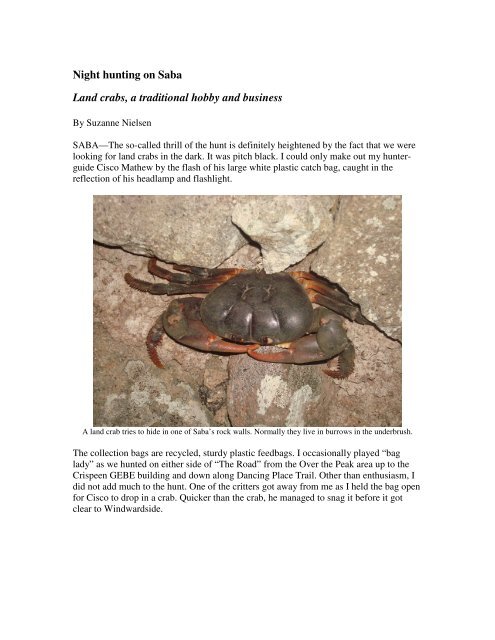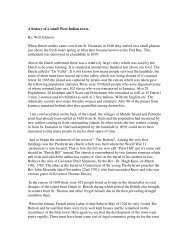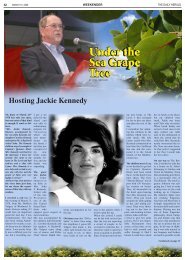Night hunting on Saba Land crabs, a traditional - Top10WorldMedia
Night hunting on Saba Land crabs, a traditional - Top10WorldMedia
Night hunting on Saba Land crabs, a traditional - Top10WorldMedia
You also want an ePaper? Increase the reach of your titles
YUMPU automatically turns print PDFs into web optimized ePapers that Google loves.
<str<strong>on</strong>g>Night</str<strong>on</strong>g> <str<strong>on</strong>g>hunting</str<strong>on</strong>g> <strong>on</strong> <strong>Saba</strong><br />
<strong>Land</strong> <strong>crabs</strong>, a traditi<strong>on</strong>al hobby and business<br />
By Suzanne Nielsen<br />
SABA—The so-called thrill of the hunt is definitely heightened by the fact that we were<br />
looking for land <strong>crabs</strong> in the dark. It was pitch black. I could <strong>on</strong>ly make out my hunterguide<br />
Cisco Mathew by the flash of his large white plastic catch bag, caught in the<br />
reflecti<strong>on</strong> of his headlamp and flashlight.<br />
A land crab tries to hide in <strong>on</strong>e of <strong>Saba</strong>’s rock walls. Normally they live in burrows in the underbrush.<br />
The collecti<strong>on</strong> bags are recycled, sturdy plastic feedbags. I occasi<strong>on</strong>ally played “bag<br />
lady” as we hunted <strong>on</strong> either side of “The Road” from the Over the Peak area up to the<br />
Crispeen GEBE building and down al<strong>on</strong>g Dancing Place Trail. Other than enthusiasm, I<br />
did not add much to the hunt. One of the critters got away from me as I held the bag open<br />
for Cisco to drop in a crab. Quicker than the crab, he managed to snag it before it got<br />
clear to Windwardside.
It’s true what they say about “Caribbean <strong>crabs</strong> in a bucket”—they scramble over <strong>on</strong>e another to get out!<br />
This night’s catch will be transferred to the crab crib.<br />
An export product<br />
It was amazing to watch this tall and nimble <strong>Saba</strong>n disappear over a vertical wall of some<br />
15 feet to scurry around in the dry leaves below to find his prey, Gecarcinus ruricola.<br />
The best time to hunt is after rain and at the dark mo<strong>on</strong> phase.
<str<strong>on</strong>g>Night</str<strong>on</strong>g> <str<strong>on</strong>g>hunting</str<strong>on</strong>g> with flashlight, headlamp, bag, and a quick hand.<br />
The main danger, if there is <strong>on</strong>e, is falling in the dark <strong>on</strong> <strong>Saba</strong>’s uncertain terrain with<br />
loose, wet, and slippery undergrowth. The critters also have a very str<strong>on</strong>g bite, and<br />
careful handling is good advice. If it does hang <strong>on</strong>, Cisco advised, put the crab down and<br />
it will immediately let go to scurry away. The safest handhold is across the carapace.
This is the right way to pick up the crab to avoid being bitten.<br />
Chef Will Caines from Lollipop’s Restaurant used to serve land crab in the shell fairly<br />
regularly with some success. His secret recipe was popular enough that tourists would ask<br />
him to freeze up a number of his special crab dishes for transport back to the USA. (This<br />
would have been in the days before tougher airline baggage security regulati<strong>on</strong>s!)<br />
Cisco is joined by a handful of other <strong>Saba</strong> hunters, including teenagers who start their<br />
college fund this way and enjoy a different night out with the boys. Arindell “Ra” Hassell<br />
of Windwardside, no l<strong>on</strong>ger hunts, but is a middleman. He has three large wooden boxes<br />
at his home that he uses to keep the catches brought to him. Some crab men must have<br />
their favourite areas, but Ra said it is hard to tell—<strong>on</strong>e night there are 30, the next time<br />
50, in the same spot. What attracts them? “They have their own system,” was Ra’s<br />
opini<strong>on</strong>.
Cisco Mathew has just fed last night’s catch, which is kept in the pen behind him.<br />
Without the lid, the <strong>crabs</strong>, who easily crawl up trees and walls, would escape in a flash.<br />
Ra’s resp<strong>on</strong>sibility is to keep the <strong>crabs</strong> healthy until he transports them to his St. Maarten<br />
clients. He must have had over 300 <strong>crabs</strong> the day I visited him. These are very rude<br />
beasts, of course, and scramble madly to get out of the crate when he opens the lid. The<br />
majority of the animals are purplish-brown in colour, but there are whitish-gray, yellow,<br />
black, and hues in between. Of course the animals must be fed until it is time for them to<br />
be shipped to market—other wise they will just eat each other! Both Ra and Cisco said<br />
that coc<strong>on</strong>uts, fruit, even left over kitchen scraps--and water of course--satisfy the <strong>crabs</strong><br />
and they have very little loss.
Ra Hassell has to move fast to keep his <strong>crabs</strong> inside the pen as they make their bid for freedom.<br />
Current crab men all recalled the late “King of Crabs” Richard “Whiskey” Simm<strong>on</strong>s, who<br />
was so proficient at the job that he paid to airlift his <strong>crabs</strong> to his St. Maarten clients.<br />
Simm<strong>on</strong>s would go out every night and fill half a dozen bags, which he tied and left<br />
roadside for pick up when he was finished for the night. Today’s crab men tend to use<br />
local fishermen or the Dawn II ferry to get their catch to market.<br />
A L<strong>on</strong>g Traditi<strong>on</strong><br />
Cisco knows the crab’s habitats, what time of m<strong>on</strong>th and year gives the best harvest, and<br />
so forth, but he might not realize that he is carrying <strong>on</strong> the legacy of a pre-historic<br />
activity.<br />
The archaeologists of Leiden University found the remains of Gecarcinus ruricola in<br />
their investigati<strong>on</strong>s of middens (refuse) dumps of the Amerindians who first inhabited the<br />
island. Middens are very valuable in showing some of what prehistoric island dwellers<br />
ate. The b<strong>on</strong>y leftovers also tell archaeologists what species were <strong>on</strong> the island before<br />
Columbus—and even before Christ! The 2001-2002 excavati<strong>on</strong>s at Plum Piece, <strong>Saba</strong>’s<br />
most ancient inhabited area at over 3,000 years old, proved that the modest land crab was<br />
<strong>on</strong> the dinner plate even then. Crab exoskelet<strong>on</strong>s (more numerous than bird or fish b<strong>on</strong>es)<br />
dominated the remains found <strong>on</strong> the locati<strong>on</strong>, said expediti<strong>on</strong> leaders Leiden University<br />
archaeologists Corinne Hofman and Menno Hoogland.
Leiden University students working over a 3,000-year old midden collecti<strong>on</strong><br />
with crab remains during a 2001 dig at Plum Piece.<br />
Today’s midden for <strong>Saba</strong> land crab is the trash barrel behind a restaurant in Marigot, <strong>on</strong><br />
the French side. The crab is not eaten <strong>on</strong> <strong>Saba</strong> any more, and local old timers said that it<br />
was not often <strong>on</strong> the family dinner menu in their memories. Fishermen used to catch<br />
<strong>crabs</strong> to use as bait. Today, crab appears to be solely an export product.<br />
More about Gecarcinus ruricola<br />
Gecarcinus ruricola has pincers of about equal size, which makes it heterochelic, if you<br />
w<strong>on</strong>dered. Since they use both claws equally, are very fast moving, and can be quite<br />
large, they pack a punch if they hold <strong>on</strong> to your finger. It is easy to distinguish male from<br />
female from the underside of the animal.<br />
The species was identified and named in 1758 by the father of the scientific binomial<br />
naming c<strong>on</strong>venti<strong>on</strong>, Carl Linnaeus, who observed, “Every year an army marches out of<br />
the forests towards the sea.” This species of crab, like all <strong>crabs</strong>, drops its fertilized eggs,<br />
which are external at this point, in seawater by “washing” them off. The eggs develop as<br />
part of the general plankt<strong>on</strong>.<br />
This mass migrati<strong>on</strong> to the sea takes place in August/September. It is easy to find road<br />
kill pictures from Florida, for example, where seacoast roads post “Crab Crossing”<br />
warning signs. However, I could not unearth a story that <strong>Saba</strong>’s land <strong>crabs</strong> have <strong>on</strong>e<br />
customary path to the sea. Yet the <strong>crabs</strong> must make the amazing trek from The Road<br />
down the almost 1,300 feet to sea level <strong>on</strong>ce a year, which would make counting at least<br />
the female populati<strong>on</strong> pretty easy. By the way, she is carrying about 85,000 eggs with<br />
her, but <strong>on</strong>ly a small porti<strong>on</strong> will ever survive their plankt<strong>on</strong> stage to experience their<br />
own migrati<strong>on</strong>.
Eco Impact<br />
This crab species is found all over the Caribbean and has different local names. It reaches<br />
maturity after five years and may live for <strong>on</strong>ly another five. They keep out of the sun<br />
during the day to c<strong>on</strong>serve moisture and forage out from their burrows during the night.<br />
They play an important role as recyclers of forest detritus. They also recycle nutrients,<br />
oxygenate the soil with their burrows, and manage forest growth by feeding <strong>on</strong> seeds and<br />
seedlings. Some varieties of land <strong>crabs</strong> are being studied in the Indian Ocean to see<br />
whether they can be used as an “indicator” species, that is a species whose abundance<br />
indicates positive envir<strong>on</strong>mental health.<br />
Enthusiastic nature lovers were <strong>on</strong>ce worried that <strong>Saba</strong>’s land crab populati<strong>on</strong> was being<br />
depleted by over harvesting. Michael Hassell, Head of the <strong>Saba</strong> Agricultural Department,<br />
said that a study was to be undertaken by Carmabi Foundati<strong>on</strong> of Curaçao in the late<br />
1980s, but he had never received the study results. A noti<strong>on</strong> was also floated that land<br />
crab farms might be organized into a business opportunity.<br />
With no tracking of crab populati<strong>on</strong>s over time, it is difficult to calculate crab numbers<br />
and possible fluctuati<strong>on</strong>s. The crab men I spoke to have not noticed a decline in the<br />
number they are able to catch. However, a truck driver said that he sees fewer <strong>on</strong> <strong>Saba</strong>’s<br />
main island road, which he crosses many times during the day and past dusk.<br />
The m<strong>on</strong>ey earned is interesting, but the sport as currently practiced is not attractive to<br />
many as an <strong>on</strong>going enterprise. In its present state, it could hardly be c<strong>on</strong>sidered as a<br />
growth export industry <strong>on</strong> <strong>Saba</strong>.<br />
Over development might so<strong>on</strong>er reduce the number of land <strong>crabs</strong> by replacing their<br />
habitat with c<strong>on</strong>crete. There is currently a lot of building <strong>on</strong> <strong>Saba</strong>, and it’s not crab<br />
burrows.






